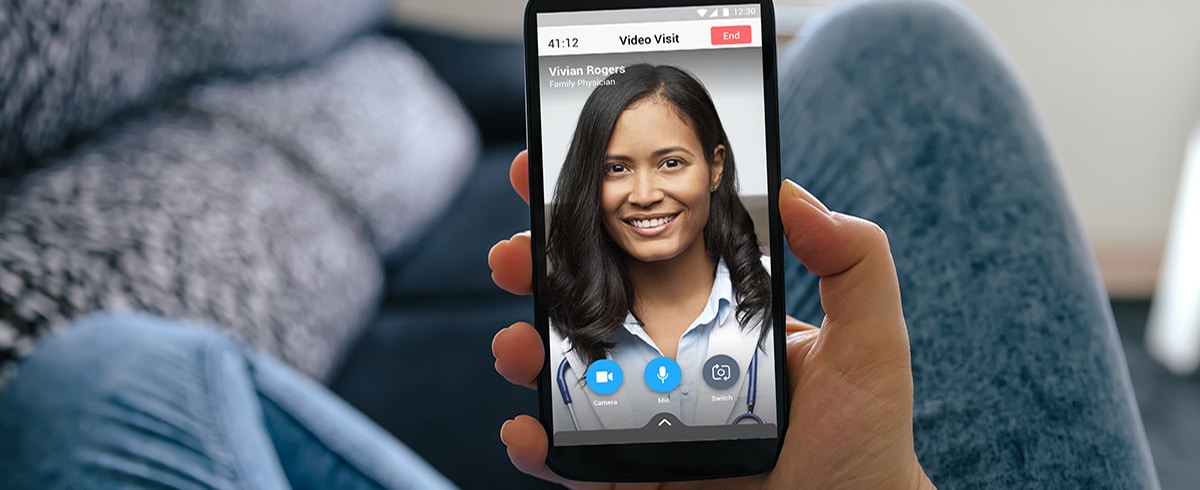When and How to Use Telehealth During the COVID-19 Pandemic
We are facing unprecedented times. No one could have predicted the surge in demand that’s happening across all of health care and the resulting strain being felt by all stakeholders — clinicians and patients especially. Many in the industry are feeling the pain of having to ration medical supplies or prioritize patients based on severity of illness. It’s a reality no one wanted, but it’s the reality we’re living in.
At Amwell, we’ve been impressed by the commitment our clients and partners have shown in taking care of their frontline clinicians while providing the highest level of care to an increased number of patients. We’ve been truly moved by the collaboration and tireless efforts that have taken place. We’ve also been humbled by longer-than-usual wait times that have increased with demand. We’re working to reduce these times by onboarding new clinicians at rates we’ve never seen before and by making enhancements to our platform to handle the surge — with more work still to be done.
As we continue our efforts, it’s also important that individual patients understand the role they too can play in this pandemic. For instance, considering the shortage of COVID-19 tests, patients can educate themselves about when they really need to get tested and, as medical visits soar both in-person and online, when they should consult a doctor.
Here are some commonly asked questions and advice for patients looking to take a proactive approach to their health, and the health of their family and community, during COVID-19.
Who should be tested for the virus?
People who have symptoms of COVID-19 AND who have been in close contact with someone with COVID-19, or who live in a community where there is active spread of COVID-19, should contact a healthcare professional to discuss whether testing is appropriate for them. The provider will decide whether a patient should be tested but remember: There is no treatment for COVID-19 and people who are mildly ill may be able to isolate and care for themselves at home.
Healthcare workers, the elderly, and those with underlying chronic conditions are at greater risk for significant illness from COVID-19 and may be more likely to get tested. People who are seriously ill, who are having difficulty breathing, or who have persistent chest pressure or pain should seek emergency medical attention.
How do I know if I should see a doctor via telehealth and whether or not that appointment can wait?
Patients should seek medical care through telehealth for COVID-19-related concerns if they have a persistent fever and cough, and don’t feel well but are not having trouble breathing. Patients who are healthcare workers, have an underlying heart/ lung condition or a weak immune system, should log on to see a doctor right away if they are encountering these symptoms. Patients with the aforementioned symptoms but who do not work in health care, do not have underlying conditions or a weak immune system should still seek medical care within the next few days, but it doesn’t have to be sought immediately.
How do I know if I should go to the emergency room versus wait to see a doctor online?
Patients who are having difficulty breathing, fever with severe cough, profound exhaustion or any medical emergency should seek emergency care immediately by calling 911 or visiting the nearest emergency room.
What can I do at home if I or someone in my household has been confirmed with or suspected of having COVID-19?
Should someone in your household be infected or suspect infection, the following measures will help protect yourself and others:
- Keep the sick person away from others. The sick person should stay in a separate room and use a separate bathroom if possible. They should also eat in their own room.
- Use face masks. The sick person should wear a face mask when they are in the same room as other people. If you are caring for the sick person, you can also protect yourself by wearing a face mask when you are in the room. This is especially important if the sick person cannot wear a mask.Remember that experts do NOT recommend wearing a face mask if you are not sick and not caring for someone who is.
- Wash hands. Wash your hands with soap and water often and for at least 20 seconds.
- Clean often. Here are some specific things that can help:
- Wear disposable gloves when you clean. It’s also a good idea to wear gloves when you have to touch the sick person’s laundry, dishes, utensils, or trash.
- Regularly clean things that are touched a lot. This includes counters, bedside tables, doorknobs, computers, phones, and bathroom surfaces.
- Clean things in your home with soap and water, but also use disinfectants on appropriate surfaces. Some cleaning products work well to kill bacteria, but not viruses, so it’s important to check labels. The United States Environmental Protection Agency (EPA) has provided a list of products for use against COVID-19.
If I haven’t been tested for COVID-19 but have self-isolated/home quarantined based on symptoms and medical advice, how do I know when I can discontinue isolation?
Before someone can come out of self-isolation, at least seven days must have passed since symptoms first appeared AND at least three days (72 hours) must have passed without symptoms. Recovery from symptoms typically include resolution of fever without the use of fever-reducing medication such as acetaminophen (Tylenol), for example, and improvement in respiratory symptoms such as cough and/or shortness of breath.


